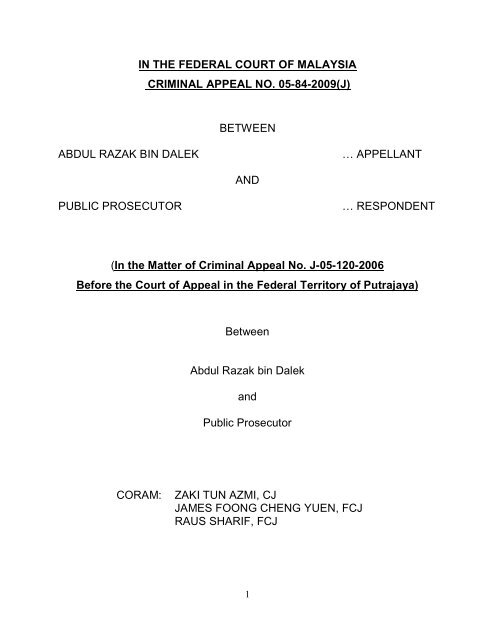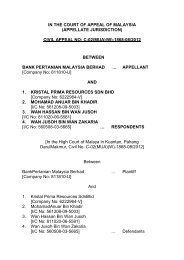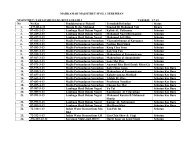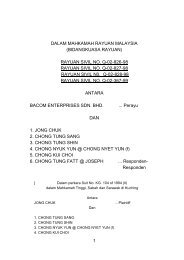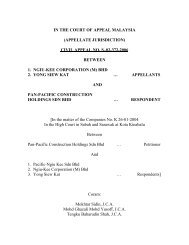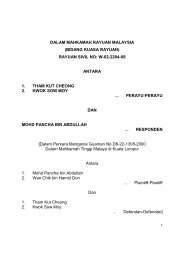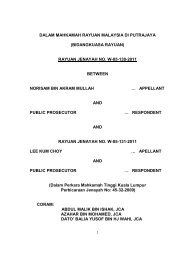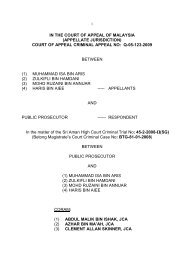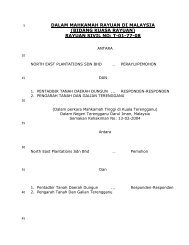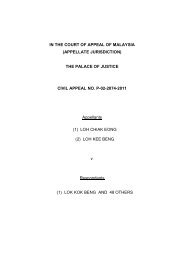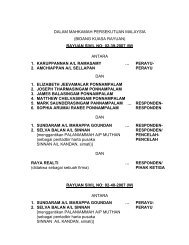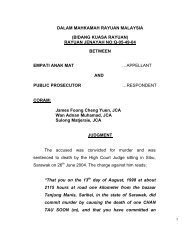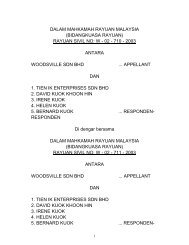between abdul razak bin dalek
between abdul razak bin dalek
between abdul razak bin dalek
You also want an ePaper? Increase the reach of your titles
YUMPU automatically turns print PDFs into web optimized ePapers that Google loves.
IN THE FEDERAL COURT OF MALAYSIA<br />
CRIMINAL APPEAL NO. 05-84-2009(J)<br />
BETWEEN<br />
ABDUL RAZAK BIN DALEK … APPELLANT<br />
AND<br />
PUBLIC PROSECUTOR … RESPONDENT<br />
(In the Matter of Criminal Appeal No. J-05-120-2006<br />
Before the Court of Appeal in the Federal Territory of Putrajaya)<br />
Between<br />
Abdul Razak <strong>bin</strong> Dalek<br />
and<br />
Public Prosecutor<br />
CORAM: ZAKI TUN AZMI, CJ<br />
JAMES FOONG CHENG YUEN, FCJ<br />
RAUS SHARIF, FCJ<br />
1
JUDGMENT OF THE COURT<br />
1. The appellant was charged with the murder of his wife, Rozita<br />
bte Haron (“deceased”) on 3 September 2001 in an<br />
unnumbered house in Parit Pecah, Parit Jawa, Muar, Johor, an<br />
offence punishable under s 302 of the Penal Code.<br />
2. The deceased was found to have died from a fatal wound to her<br />
throat which had been slit, with the carotid artery severed. The<br />
forensic pathologist, who conducted the post mortem on the<br />
deceased, concluded that the death would have occurred within<br />
three minutes of the injury being inflicted.<br />
3. The death occurred in the kitchen of Rokiah <strong>bin</strong>ti Dawi (PW8)’s<br />
house. PW8 is the sister in law of the appellant. She was<br />
present in the immediate vicinity at the time of the incident but<br />
did not witness the actus reus. According to her, sometime<br />
<strong>between</strong> 7.00 am to 8.00 am on 3 September 2001 the<br />
deceased came to her house followed by the appellant about<br />
10-15 minutes later. The appellant’s house was about 10 feet<br />
away from PW8’s house.<br />
4. It is an undisputed fact that at that material time the deceased<br />
was no longer living with the appellant. The deceased though<br />
not divorced by the appellant, had left him sometime in June<br />
2001. However, on the day of the incident, the deceased<br />
came back to the matrimonial home to visit her son, Mohd Rafiz<br />
2
(PW10) who was having a fever. Coincidently one day before<br />
the incident, PW8 and her husband, Mohd Yusof <strong>bin</strong> Dalek<br />
(PW11) had held a wedding ceremony for their daughter at their<br />
house. It is for that reason the deceased went to PW8’s house,<br />
after visiting PW10, as she could not make it on the wedding<br />
day.<br />
5. According to PW8, she and the deceased were in the kitchen<br />
when the appellant arrived. PW8 then went out to the barn<br />
(bangsal) outside the house to take some ‘nasi minyak’ for the<br />
deceased, after which she came back to the kitchen. On her<br />
way to the kitchen, she heard the appellant saying to the<br />
deceased “Abang pegang Ita pun tak boleh. Ita kan masih<br />
isteri abang”. (Ita was the deceased’s shortname). At that<br />
time, the appellant and the deceased were side by side. They<br />
were standing at PW8’s kitchen door. PW8 then placed the<br />
‘nasi minyak’ on the stove and then went to the toilet outside<br />
the house. When PW8 re-entered the kitchen, the appellant<br />
and the deceased were still at the kitchen door. Then, as PW8<br />
was heating up the ‘nasi minyak’, the deceased came from the<br />
rear and patted PW8’s right shoulder and called out PW8’s<br />
name “Kak Kiah”. PW8 turned and saw blood on the deceased<br />
and at the kitchen door where the deceased had stood earlier.<br />
The deceased could barely walk and subsequently collapsed<br />
on the floor. At the same time, PW8 saw blood on the<br />
appellant’s neck and subsequently saw the appellant hitting his<br />
head against the wall.<br />
3
6. Another main witness for the prosecution was PW11.<br />
According to PW11, at about 8.00 am on 3 September 2001 he<br />
was at the bangsal by the side of his house to clean some<br />
unwashed pots. When he was there, he saw his wife, PW8<br />
taking some ‘nasi minyak’ from a cooking pot. PW11 asked<br />
PW8 who would want to eat ‘nasi minyak’ that early in the<br />
morning. PW8 replied it was the deceased. PW8 also told<br />
PW11 that the appellant was also in their house. PW11<br />
continued with his chores. About 10-15 minutes later, PW11<br />
heard a loud voice of a quarrel inside the house. According to<br />
PW11, he paid no attention because he was used to the quarrel<br />
<strong>between</strong> the appellant and the deceased. However, about 5-6<br />
minutes later, PW11 heard the voice of the deceased crying out<br />
“Kak Kiah”. PW11 rushed into the kitchen and there he saw the<br />
deceased, who was covered with blood, staggering in the<br />
kitchen. The deceased then collapsed onto the floor. At that<br />
time, the appellant was in the kitchen. He was holding a knife<br />
and was pointing the knife at himself. When PW11 tried to<br />
seize the knife from the appellant, the appellant stabbed his<br />
own neck with it. Then the appellant collapsed to the floor. The<br />
appellant who was still holding the knife pointed it at his<br />
stomach. PW11 eventually succeeded in seizing the knife from<br />
the appellant.<br />
7. Both PW8 and PW11 confirmed that the knife does not<br />
originate from their house. However, PW10 testified that the<br />
4
knife belongs to the appellant and the appellant had used the<br />
knife for gardening purposes.<br />
8. At the end of the prosecution’s case, the learned High Court<br />
Judge found that the prosecution had made out a prima facie<br />
case against the appellant. He found that it was the appellant<br />
who inflicted the injury on the deceased. He also found that the<br />
bodily injury to the deceased caused by the appellant was<br />
sufficient in the ordinary cause of nature to cause not only<br />
death but certain death. The learned High Court Judge<br />
concluded that the act of the appellant in inflicting the injury was<br />
proof of the appellant’s intention to cause death.<br />
9. When the defence was called, the appellant gave evidence on<br />
oath. Four other witnesses also gave evidence for the defence.<br />
Basically the appellant put up a defence of grave and sudden<br />
provocation under the exception 1 of s 300 of the Penal Code.<br />
10. In his evidence, the appellant confirmed that the deceased left<br />
the matrimonial house two months before the 3 September<br />
2001 incident. According to him, the deceased left him when<br />
he asked her of a call she made to a telephone number 019-<br />
7412027 which costs RM22.00 which was reflected in the bill<br />
that he received. The deceased replied that if he calls that<br />
telephone number she would leave him for that man. The next<br />
day, the deceased did not return home from work. She worked<br />
as a cleaner at Muar Hospital.<br />
5
11. The appellant further stated that he had tried to persuade the<br />
deceased many times to return home but failed. Thus, on the<br />
day of the incident, when he found out that the deceased had<br />
come back and was in PW8’s house, he was happy because<br />
he still loved her. However, when he met the deceased, she<br />
did not reciprocate. The deceased spurned him and told him<br />
that “sekarang kita bukan suami isteri lagi, kita cuma kawan<br />
sahaja”. The appellant said he could not accept what was said<br />
by the deceased because she was still his wife. He understood<br />
the words of the deceased to mean that there was no more<br />
relationship <strong>between</strong> them. The appellant described how he<br />
felt then and what happened thereafter in his own words as<br />
follows:-<br />
“Perasaan saya macam hilang fikiran dan hilang<br />
ingatan. Saya tidak terima hakikat kata Rozita<br />
kerana dia masih isteri saya. Saya masuk rumah<br />
ambil pisau untuk potong dawai bangsal. P8A<br />
adalah pisau yang saya ambil. Saya ambil pisau itu<br />
dari dalam bilik tidur saya. Saya simpannya di<br />
dalam bilik tidur saya, sebab takut budak buat main.<br />
Saya ambil P8A untuk tujuan memotong dawai<br />
bangsal. Dengan pisau, saya turun rumah. Fikiran<br />
saya <strong>bin</strong>gung dan hilang ingatan. Dengan pisau<br />
saya pergi ke rumah SP8. Lepas itu saya tak ingat,<br />
saya sedar saya berada di hospital sahaja”.<br />
6
12. The learned High Court Judge rejected the appellant’s defence<br />
grave and sudden provocation. The learned Judge found that<br />
there was nothing grave in the words or acts of the deceased to<br />
make the appellant lose his self-control. He found on the facts<br />
and circumstances of the case that there was no grave and<br />
sudden provocation that would have deprived a reasonable<br />
man of the power of self control. Accordingly, the appellant<br />
was found guilty. He was convicted and sentenced to death.<br />
13. The appellant appealed to the Court of Appeal. He advanced<br />
the following grounds:-<br />
(i) improper identification of the deceased to the forensic<br />
pathologist;<br />
(ii) the evidence of pronouncement of the deceased’s death<br />
at the scene was hearsay;<br />
(iii) sudden and grave provocation;<br />
(iv) non-insane automatism; and<br />
(v) sudden fight.<br />
14. Grounds (iv) and (v) were not raised before the High Court.<br />
They were only raised before the Court of Appeal.<br />
7
15. The Court of Appeal found no merit on all the grounds raised by<br />
the appellant. Accordingly, the appellant’s appeal was<br />
dismissed (see Abd Razak Dalek v PP [2010] 2 CLJ 956).<br />
16. Before us, the same grounds of appeal were advanced by the<br />
appellant. However, the main ground of the learned counsel’s<br />
argument was on the defence of automatism.<br />
17. In Malaysia, the defence of automatism is covered under<br />
unsoundness of mind, which is found in s 84 of the Penal Code<br />
which reads:-<br />
“84. Act of a person of unsound mind.<br />
Nothing is an offence which is done by a person<br />
who, at the time of doing it, by reason of<br />
unsoundness of mind, is incapable of knowing the<br />
nature of the act, or that he is doing what is either<br />
wrong or contrary to law.”<br />
However, s 84 of the Penal Code must be read together with s<br />
105 of the Evidence Act 1950, which placed the onus on the<br />
accused to establish such defence (see PP v Kenneth Lee<br />
Fook Mun Lee (No. 1) [2002] 2 MLJ 563), Sinnasamy v<br />
Public Prosecutor [1956] MLJ 36).<br />
8
18. For convenience s 105 of the Evidence Act 1950 is reproduced<br />
below:-<br />
“105. Burden of proving that case of accused<br />
Comes within exceptions<br />
When a person is accused of any offence, the<br />
burden of proving the existence of circumstances<br />
bringing the case within any special exception or<br />
proviso contained in any part of the same Code, or<br />
in any law defining the offence, is upon him, and the<br />
court shall presume the absence of those<br />
circumstances.<br />
ILLUSTRATIONS<br />
(a) A. accused of murder alleges that by reason of<br />
unsoundness of mind he did not know the nature of<br />
the act.<br />
The burden of proof is on A.”<br />
19. It is clear from the above that for an accused to rely on s 84 of<br />
the Penal Code as a defence, the burden is on him to establish<br />
his condition of mind at the time of the commission of the<br />
offence. In such a situation the prosecution will be entitled to<br />
9
adduce evidence of rebuttal and the defence may adduce<br />
evidence in sub-rebuttal if there is a need for it.<br />
20. However, learned counsel for the appellant submitted that the<br />
appellant was not relying on the defence under s 84 of the<br />
Penal Code. Instead, the appellant was relying on the defence<br />
of non-insane automatism. Learned counsel submitted that<br />
there are two types of automatism, namely, insane and non-<br />
insane automatism (Bratty v Attorney General for Nothern<br />
Ireland [1961] 46 Cr App R 1, Rv Hennessy [1989] 2 ALL ER<br />
9; R v Barry Douglas Burgess [1991] 93 Cr App R 41).<br />
Insane automatism refers to a situation where the primary<br />
cause of abnormality is internal to the accused and prone to<br />
recur. The condition is classified as a disease of the mind.<br />
Non-insane automatism occurs where the abnormality is<br />
caused by a factor external to the accused, for example a blow<br />
to the head, medication, alcohol or drugs.<br />
21. It was further submitted that the distinction <strong>between</strong> sane<br />
automatism and non-insane automatism is important as it will<br />
determine the onus of proof (Police v Bannin [1991] 2 NZLP<br />
337). For sane automatism, where the condition is a disease of<br />
the mind, the onus will be on the accused to establish the<br />
defence. But for non-sane automatism where the condition<br />
does not produce a disease of the mind, the onus will be upon<br />
the prosecution to exclude the alleged incapacity. This, as<br />
10
submitted by the learned counsel is what the prosecution had<br />
failed to do in this case.<br />
22. After laying down the law, learned counsel then referred to the<br />
relevant evidence in this case. He referred to PW8’s evidence<br />
where PW8 said she saw the appellant hitting his head against<br />
the wall after the incident. He then submitted that the inference<br />
needed to be drawn from that evidence was that the appellant<br />
must have also hit his head against the wall too before the<br />
incident which caused him to behave in a disassociative<br />
manner as witnessed by PW8 and PW11. And this is also<br />
consistent with what was said by the appellant in his cautioned<br />
statement. Thus, it was submitted that the prosecution has the<br />
legal burden to eliminate the alleged incapacity. He contended<br />
that no burden of proof is imposed upon the appellant raising<br />
such defence beyond pointing to the facts which indicate the<br />
existence of such a defence.<br />
23. In support of his argument, learned counsel referred us to the<br />
majority judgment of the Supreme Court of Ontario in Wayne<br />
Kenneth Rabez v Her Majesty The Queen [1980] 2 S.C.R<br />
513 at pg 515 where it was held:-<br />
“The first principle fundamental to our criminal law<br />
which governs this appeal is that no act can be a<br />
criminal offence unless it is done voluntarily. The<br />
prosecution must prove the state of mind of the<br />
11
accused. The circumstances are normally such as<br />
to permit a presumption of volition and mental<br />
capacity. This is not so when the accused, as here,<br />
has placed before the Court evidence sufficient to<br />
raise an issue that he was unconscious of his action<br />
at the time of alleged offence. No burden of proof is<br />
imposed upon the accused raising such defence<br />
beyond pointing to facts which indicate the<br />
existence of such condition.”<br />
24. Learned counsel also referred to us the case of Bratty v AG<br />
for Nothern Ireland [Supra] at pg 530 where Viscount Kilmuir,<br />
LC said:-<br />
“… for a defence of automation to be “genuinely<br />
raised in a genuine fashion” there must be evidence<br />
on which a jury could find that a state of automatism<br />
exists. By this I mean that the defence must be<br />
able to point to some evidence, whether it emanates<br />
from their own or from the Crown’s witnesses, from<br />
which the jury could reasonably infer that the<br />
accused acted on a state of automatism.”<br />
25. We have no issue on the principle of law established in the two<br />
cases. The question is, has the appellant placed before the<br />
Court sufficient evidence to raise the issue that he was<br />
unconscious of his action at the time of the alleged offence.<br />
12
Also, has the defence been able to point to some evidence,<br />
whether it emanates from their own or from the prosecution’s<br />
witnesses, for which this Court could reasonably infer that the<br />
appellant acted on a state of non-insane automatism.<br />
26. We have carefully scrutinised the evidence on record in this<br />
case and we are unable to find sufficient evidence whether<br />
from the defence own evidence or from the prosecution<br />
witnesses which could reasonably infer that the accused acted<br />
in a state of non-sane automatism. On the other hand, the<br />
evidence in this case indicates otherwise. In this case, the<br />
appellant was able to relate what had happened prior to the<br />
stab<strong>bin</strong>g incident with great detail. In fact, before the incident<br />
there were exchanges of words <strong>between</strong> the appellant and the<br />
deceased, reflecting a sane person who wishes to woo his wife<br />
back into their marriages which was on the rock. And most<br />
importantly, the appellant remembered taking the knife. This<br />
indicates that the appellant was mentally alert and knew what<br />
he was doing. He has the intention to commit murder.<br />
27. In our view, before any burden is placed on the prosecution to<br />
disprove non-sane automatism, there must be some evidence<br />
to indicate that the appellant was or could have been suffering<br />
from such alleged incapacity. Based on the learned counsel’s<br />
submission our understanding is that the external factor which<br />
was alleged to have caused the non-sane automatism which<br />
incapacitated the appellant was the concussion, which the<br />
13
learned counsel contended, was brought about by the act of the<br />
appellant before the incident hitting his head against the kitchen<br />
wall. However, there is no evidence of this. There was no<br />
cross-examination of PW8 and PW11 on this issue or any<br />
evidence adduced that may assist the Court to make an<br />
inference that the appellant was hitting his head against the<br />
wall before the incident. PW8’s and PW11’s evidence on the<br />
appellant’s disassociative behavior was only after the incident.<br />
In the absence of such evidence, no legal burden can be<br />
imposed on the prosecution to exclude the alleged incapacity.<br />
Furthermore, the facts and the events that led to the death of<br />
the deceased do not support the appellant’s contention that he<br />
was in the state of non-sane automatism, when he slit the<br />
throat of the deceased. Accordingly, this defence raised by the<br />
appellant must fail.<br />
28. As indicated earlier, the appellant’s counsel has also raised a<br />
number of other issues. For completeness, we will take them in<br />
turn. The first was with regard to the improper identification of<br />
the deceased to the forensic pathologist. It was argued that the<br />
proper person to identify the deceased to the forensic<br />
pathologist should have been a family member or the police<br />
corporal who had taken the body to the Muar Hospital and not<br />
the Investigating Officer. With respect, this is a non issue. As<br />
rightly pointed out by the Court of Appeal, several witnesses<br />
who were present at the murder scene have identified the<br />
deceased’s identity and the fact of her death is beyond<br />
14
easonable doubt. Thus, in the circumstances of the case, it<br />
was proper for the Investigating Officer to identify the body of<br />
the deceased to the forensic pathologist.<br />
29. The second issue was that no one had witnessed the actus<br />
reus. Again, we agree with the conclusion of the Court of<br />
Appeal that although there was no eye witness to the actus<br />
reus, the com<strong>bin</strong>ation of the evidence of several witnesses who<br />
were present at the murder scene together with the medical<br />
evidence could only lead the court to one conclusion: The<br />
deceased’s death was caused by the appellant’s act.<br />
30. The third issue was on the defence of grave and sudden<br />
provocation. On this ground, we are in agreement with the<br />
conclusion of the trial judge as well as the Court of Appeal that<br />
what the deceased did was insufficient to amount to a grave<br />
and sudden provocation in law and the appellant’s act of cutting<br />
of the deceased throat was clearly out of proportion to the<br />
alleged provocation.<br />
31. Finally, on the defence of a sudden fight. Again we agree with<br />
the Court of Appeal’s finding that there was no evidence to<br />
establish a fight let alone a sudden fight <strong>between</strong> the appellant<br />
and the deceased.<br />
15
32. For the reasons already given, we hereby dismiss the appeal.<br />
The conviction and sentence imposed on the appellant by the<br />
courts below are therefore affirmed.<br />
Dated this 4 th day of June 2010.<br />
Raus Sharif<br />
Judge<br />
Federal Court, Malaysia<br />
Counsel for the appellant: En. T. Vijay<br />
Cik Maslin bt. Khalil<br />
Solicitors for the appellant: Tetuan Khalil & Co.<br />
Counsel for the respondent: En. Awang Armadajaya<br />
Solicitors for the respondent: Jabatan Peguam Negara Malaysia<br />
16


